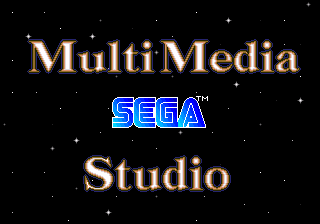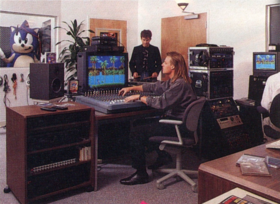Sega Multimedia Studio
From Sega Retro

| ||
| Sega Multimedia Studio Division of Sega of America | ||
|---|---|---|
| Founded: 1991[1] | ||
| Defunct: 1994[2] | ||
Headquarters:
| ||
1992 1994
|
This short article is in need of work. You can help Sega Retro by adding to it.
Sega Multimedia Studio was a development division created by Sega of America in response to the multimedia revolution of the early 90’s, featuring advanced audio video creation facilities and a state-of-the-art recording studio. Established over a period of late 1991 to early 1992 as a continuation of the audio management capabilities of the Product Development Team, it worked on nearly two-dozen titles and produced two of their own before being broken up around 1994.[2]
Contents
History
In late 1991[3], Ken Balthaser established Sega Multimedia Studio in an attempt by management to refocus the company's internal development capabilities around the CD-ROM and the upcoming Sega CD. According to developers, "the transition from Genesis synth chip to CD and digital audio pointed to a lot of speculation."[4] Soon after in early 1992[2], the Product Development Team had its audio department officially migrated to Sega Multimedia Studio.
Largely managed by Ken Balthaser, David Javelosa, and others, the group specialized in the field of "multimedia"; that is, the combination of different types of interactive media that the new storage format of compact discs offered. In fact, the Studio's utlization of the word multimedia largely precedes the mainstream introduction of the word in 1993, with Sega of America possibly being one of the first major technology companies to use the word.[5] Now seen as a speculation-fueled bubble that grossly overestimated consumer interest, Sega of America was allowed to join in as well, thanks to its overwhelming success with the Genesis. The studio would assist in the development of media-based games for the Sega CD, such as the platform's FMV titles. Additionally, it's support bolstered the cutting-edge, "better than Nintendo" corporate image Sega of America had created for the United States market at the time. Al Nilsen recalls that even famed Sega collaborator Michael Jackson visited the studio on a number of occasions.
During this time, Javelosa recalls that it was not uncommon for Spencer Nilsen, one of the director's promising new hires, to be found sleeping in the recording studio's control room.[4] Reportedly, the studio worked on a number of titles which were left unreleased. Most notable among these was a SETI-themed game featuring the endorsement of celebrity astronomer Fiorella Terenzi.[2]
Around 1994[2], the audio department was spun-off into Sega Music Group[4] (led by Spencer Nilsen, who had long desired a music studio away from Sega of America's overlook[4]), Creative Support[4], and Developer Technical Support[2], with many staff moving to Gametek as a result.[6] Some staff appeared to have remained at Multimedia Studio after the split, with this team dedicated to supporting first-party developers (where Creative Support worked with third-party developers instead).[2] It is unknown how long this team remained before the studio's total closure around or following 1994.
Softography
Mega Drive
- (1993) (audio)
Mega-CD
- (1992)
- (1993)
- (1995)
Saturn
- (unreleased)
Nintendo Switch Online
- (2022) (audio)
Steam
- (2010) (audio)
iOS
- (2010) (audio)
List of staff
Photographs
- Main article: Photos of Sega Multimedia Studio
References
- ↑ K Horowitz (2016). Playing at the Next Level: A History of American Sega Games
- ↑ 2.0 2.1 2.2 2.3 2.4 2.5 2.6 Interview: David Javelosa (2023-12-09) by Alexander Rojas
- ↑ K Horowitz (2016). Playing at the Next Level: A History of American Sega Games
- ↑ 4.0 4.1 4.2 4.3 4.4 Interview: David Javelosa (2008-07-02) by Sega-16
- ↑ Interview: Doug Lanford (2011-03-01) by Sega-16
| Timeline of Sega of America research and development divisions |
|---|
|
86
87
88
89
90
91
92
93
94
95
96
97
98
99
00
01
02
03
04
05
06
07
08
09
10
11
12
13
14
15
16
17
18
19
20
21
22
23
|
